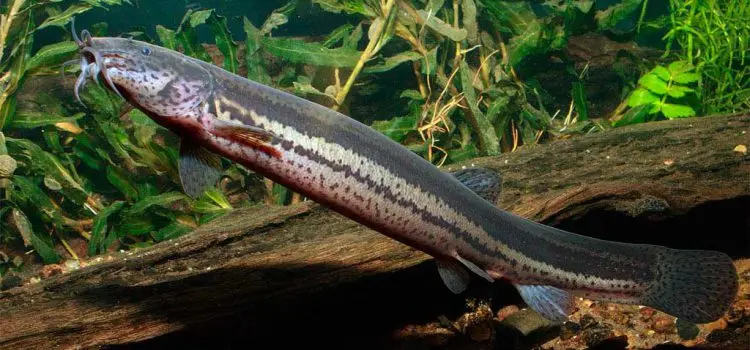Contents

Many are repelled by the unattractive appearance of the loach, which, like the eel, has a serpentine shape. In addition, when you take it in your hands, it wriggles very strongly and makes a peculiar sharp squeak.
Summary painting body – gray-yellow, brownish back. On the sides of the body there is a wide strip from the eye to the tail. The belly is yellow or even reddish. All fins brown, with dark spots.
The largest member of this family. Reaches length 25-30 cm, in Kama – up to 35 cm, but usually the length is about 23 cm and weight 140 g. Life expectancy is 6-7 years.
Life
Vyun leads settled way of life, often buried in silt. Adheres mostly to marshy, slowly flowing or stagnant waters. In rivers, it prefers muddy areas overgrown with dense aquatic vegetation, often in channels, bays or oxbow lakes. Lives even in such swampy lakes and ditches, where there is no other fish, even crucian carp. In such swampy reservoirs, the loach often rises to the very surface of the water, lets out the exhaust air and swallows a new portion, while emitting a characteristic squeak (in some places it is called squeak, hence the generic name loach).

First of all, it is striking in its extraordinary vitality and amazing resourcefulness. It is very unpretentious to the oxygen content in water, for this it has an additional intestinal respiration. It happens that small lakes dry up completely in very dry years. The inhabitants of these reservoirs for the most part either die or become easy prey for birds and humans. It would seem that the loach should share this fate. But then the rainy season comes, the lake bowl is filled with water again and, like a phoenix bird, the loach resurrects in it. This fish has a rare ability to burrow into silt to a depth of one or two meters and dive into hibernation, which continues until water reappears. In general, the loach can live in almost any stagnant water, and even in swamps.
The rare ability of the loach to remain alive for a long time without water is explained by the fact that, unlike most fish, it can breathe not only with gills, but also with the help of skin and intestines. His intestinal walls are rich in blood vessels and perform respiratory functions when the body lacks oxygen. Swallowing air, the loach passes it through the digestive canal, and then releases it through the respiratory opening (this is precisely what explains squeak loaches when they are pulled out of the water). Some anglers claim that large loaches, as well as eels, can in dewy morning hours crawl over from one reservoir to another, nearby.

The loach has another interesting feature: it is sensitive to changes in atmospheric pressure. Before bad weather, he begins to worry and constantly protrude to the surface (10-15 times per minute). For this property, the loach is called a living barometer. In a number of countries, in particular in Japan, loaches, like other meteorological fish, are specially kept in aquariums. By their behavior, scientists often learn not only about changing weather conditions, but also about the approach of natural disasters such as tsunamis and earthquakes.
Food
It feeds on insect larvae (especially chironomids), crustaceans, worms, small mollusks, as well as detritus and partially bottom vegetation. Can live without food in captivity up to six months. In addition, the loach is known as an active eater of alien caviar. Hardly any inhabitant of rivers and lakes can compete with him in the ability to look for her at the bottom. He is engaged in this so actively that other fish often completely disappear in small reservoirs. Carp, carp, tench suffer the most from loaches.

In the aquarium, the loach is voracious (as in the wild) and greedily grabs bloodworms, raw meat, earthworms, ant eggs, and picks up food only from the bottom. He finds food by touch (he has 10 antennae on his head around his mouth, which serve as the main organs of touch).
Reproduction
Spawns in spring and summer, in southern reservoirs, loaches often go to spawn on spills, and then their larvae are found far from a river or lake. The female spawns 100-150 thousand eggs among the algae. Eggs with a diameter of 1,7-1,9 mm are slightly sticky, slightly brownish in color. At a water temperature of 14-16 ° C, incubation lasts about 4 days.

Hatched prelarvae 6,9 mm long have gluing organs and additional respiratory organs in the form of external gills. In addition, larvae the respiratory function is carried out by a dense network of blood vessels in the large pectoral fins, in the anal fold, and later in the back of the intestine. With a length of about 8 mm, at the age of 12 days, the larvae switch to external feeding. They search for food with the help of special sense organs located around the mouth and on the antennae, which develop very early. At the age of 26 days, the external gills are completely reduced. Malkovy the period begins when the length reaches 30 mm.
Distribution
The loach is widely distributed from France (the Loire River) to the Urals, inhabiting the water bodies of the basins of the North and Baltic Seas. There is no loach in the Arctic Ocean basin, in Scandinavia, Great Britain, Italy, Greece and the Iberian Peninsula, rare in Denmark.









